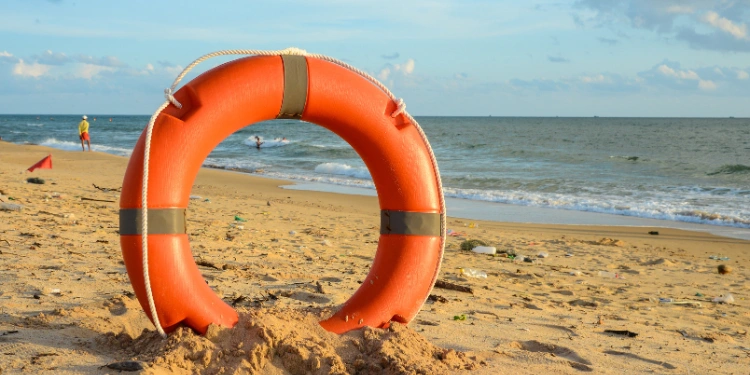Maroubra Beach Drama: How Lifeguards Saved Dozens from Sudden Rip Current Emergency
The Sudden Emergency at Maroubra Beach
A Day at the Beach Takes a Turn
On a serene Monday afternoon, Maroubra Beach in Sydney was bustling with activity.
Families, friends, and swimmers were enjoying the sun and surf, unaware that this day would soon turn into a dramatic event.
The tranquility was abruptly disrupted at 3:20 PM when the unmistakable sound of the shark alarm pierced the air, causing immediate concern and confusion.
Swimmers, gathering their children and belongings, hastily made their way to the shore.
Unseen Danger: The Flash Rip Current
As the crowd gathered, anxiety grew.
The shark alarm had raised fears of a possible shark sighting, causing widespread alarm.
However, the true danger was not from a predator of the deep but from the very water itself.
Over 20 swimmers had been ensnared by an unexpected flash rip current—a powerful and swift-moving underwater force that was invisible until it was too late.
Spectators watched in horror and anticipation, straining to see what was unfolding in the water.
It quickly became apparent that the peril was not from a shark, as initially feared, but from the sudden and treacherous rip conditions prevailing that day.
Clarification Secured Calm
The Maroubra Beach Surf Life Saving Club quickly clarified the panic.
A spokesperson announced that the alarm activation was precautionary and aimed to clear the water efficiently for a mass rescue operation.
By alerting everyone and preventing further entries into the surf, lifeguards could focus on the pressing task of rescuing the swimmers caught in the rip.
The flash rip had caught even seasoned beachgoers off guard, rendering them helpless against its pull.
The beach was cleared quickly, and attention turned to the lifeguards now battling the challenging conditions.
Next, we will explore the swift and coordinated response from the lifesaving teams that made the rescue operation a success despite the harsh water conditions.
 The lifeguard team was essential
The lifeguard team was essential
Swift Response from Lifesaving Teams
When the initial shark alarm went off at Maroubra Beach at 3:20 PM, both volunteer lifeguards and professional lifesavers sprang into action.
The alarm was quickly clarified to indicate dangerous rip conditions, not the presence of sharks.
This efficient communication set the stage for a well-coordinated rescue operation.
Coordinated Effort
The rapid response was made possible by the synchronized work between the Maroubra Beach Surf Life Saving Club’s volunteer lifeguards and the professional lifesaving teams.
Despite the tricky water conditions, which included powerful rip currents and challenging waves, the lifesavers executed their duties seamlessly.
Their cooperation showcased just how crucial teamwork is in these high-stress situations, allowing them to rescue over 20 swimmers caught in the flash rip.
Challenging Conditions
The surf conditions on that Monday afternoon presented significant challenges.
The sudden rip current was not only powerful but also unexpected, making it difficult for swimmers to navigate and for rescuers to carry out their tasks.
Nevertheless, the lifesaving teams managed the situation adeptly, ensuring that all trapped swimmers were safely brought back to shore.
Strategic Use of Shark Alarm
One of the standout strategies employed during the rescue was the use of the shark alarm system.
By sounding the alarm, the lifeguards efficiently cleared everyone from the water, which significantly reduced the risk of further incidents and allowed the rescuers to focus on saving those in immediate danger.
This tactical decision illustrated the lifesaving teams’ ability to adapt and utilize available resources effectively in emergency situations.
The life-saving teams’ quick thinking and strategic actions were vital in handling the emergency at Maroubra Beach.
Respects to the seamless coordination and adaptability of both volunteer and professional lifesavers, the beachgoers’ safety was secured, even in the face of daunting natural elements.
Secondary Emergency and Further Action
Beach Flags Relocation
Once the initial emergency was under control at Maroubra Beach, lifeguards quickly strategized ways to prevent further incidents.
Realizing the danger posed by the powerful rip current, they decided to relocate the beach flags to a safer area.
This strategic move provided a new designated swimming zone, free from the immediate threat of another rip forming.
This adjustment was essential for ensuring the safety of beachgoers and preventing future rescues.
Additional Mass Rescue
However, moving the flags did not completely eliminate the danger.
Shortly after the relocation, another set of swimmers, approximately ten in total, found themselves in trouble.
These swimmers were caught in the new swimming area, where conditions were still tricky due to shifting currents.
Lifeguards and lifesavers sprang into action once again, performing another mass rescue.
The successful retrieval of these swimmers demonstrated the teams’ readiness and adaptability in high-stress scenarios.
Ongoing Preventive Measures
Throughout the afternoon, lifeguards remained vigilant.
They implemented a series of preventive measures to keep beachgoers safe.
Lifeguards continuously patrolled the new swimming zone, educating the public on safer swimming practices and the potential hazards of rip currents.
Regular announcements were made over the loudspeakers, reminding swimmers to stay within the marked areas and remain cautious of the water conditions.
The beach saw increased surveillance and manpower, with more lifeguards positioned at strategic points along the shore.
This ensured that any signs of a developing emergency could be addressed immediately.
These preventive steps were critical in maintaining order and safety on a day marked by challenging surf conditions.
Transition to Concluding Actions
With these well-orchestrated efforts, the situation at Maroubra Beach remained under control for the remainder of the afternoon.
Lifeguards and lifesavers exhibited exceptional coordination and swift decision-making, showcasing the comprehensive emergency response protocols in place.
These measures not only resolved the immediate danger but also reinforced the importance of proactive beach management.
Resolution and Safety Measures
Following the initial chaos at Maroubra Beach, lifeguards swiftly relocated the beach flags to designate safer swimming zones.
This action proved crucial, as just after the repositioning, a secondary mass rescue was needed when another 10 swimmers were caught in the turbulent waters.
The quick thinking and effective communication among the lifesaving team ensured these swimmers were promptly and safely brought to shore.
Throughout the afternoon, lifeguards implemented multiple preventive measures to enhance beachgoers’ safety. This included:
- Regular announcements over the public address system to keep visitors informed of the current conditions
- Increased surveillance to monitor the waters more meticulously
- Public education on rip current safety, helping swimmers recognize and avoid risky areas
A key preventive action was the decision to close the beach at 6 PM.
This measure was pivotal in preventing further incidents as daylight waned and visibility lessened.
The closure ensured that no more swimmers would be at risk in the perilous conditions.
The Maroubra Beach incident highlighted the efficiency of emergency response protocols.
The combination of swift decision-making, well-coordinated rescues, and proactive safety measures showcased the lifesaving team’s proficiency.
These efforts not only managed the immediate crisis effectively but also set a high standard for future beach safety regulations and responses.
This event underscores the critical importance of well-coordinated, immediate responses to beach emergencies and the vital role preventive safety measures play in managing coastal areas.
Lessons from the Maroubra Incident
The dramatic events at Maroubra Beach underscored several critical lessons about beach safety and emergency response.
Importance of Immediate Response to Beach Emergencies
One of the most crucial lessons from the Maroubra incident is the need for an immediate response to beach emergencies.
The rapid activation of the shark alarm at 3:20 PM was pivotal in quickly clearing the water of swimmers, minimizing the risk of further entrapments in the unexpected rip current.
Quick thinking and fast action are essential in preventing what could easily escalate into a tragic situation.
Critical Role of Well-Coordinated Lifesaving Teams
The incident highlighted the effectiveness of well-coordinated lifesaving teams.
Volunteer lifeguards and professional lifesavers worked together seamlessly to ensure the safety of over 30 swimmers caught in hazardous conditions.
Their coordinated effort, especially in tricky water conditions, proved to be lifesaving.
This synergy between volunteer and professional teams is a model for beach safety management, demonstrating how vital it is for lifesaving teams to train and operate in unison.
Value of Preventive Safety Measures in Beach Management
Preventive safety measures played an indispensable role in managing the crisis at Maroubra Beach.
Relocating the beach flags to indicate safer swimming areas was one such measure.
This strategic shift helped prevent further incidents and ensured that lifeguards could better monitor swimmer safety.
Moreover, ongoing preventive measures like regular announcements and increased surveillance maintained swimmer awareness and readiness.
The decision to close the beach at 6 PM emphasized the prioritization of public safety over convenience, underscoring the importance of caution in managing natural hazards.
Drawing on the experiences and protocols seen during the Maroubra emergency, it’s evident that a combination of rapid response, coordinated rescue efforts, and preventive safety measures can significantly enhance beach safety and emergency management.







